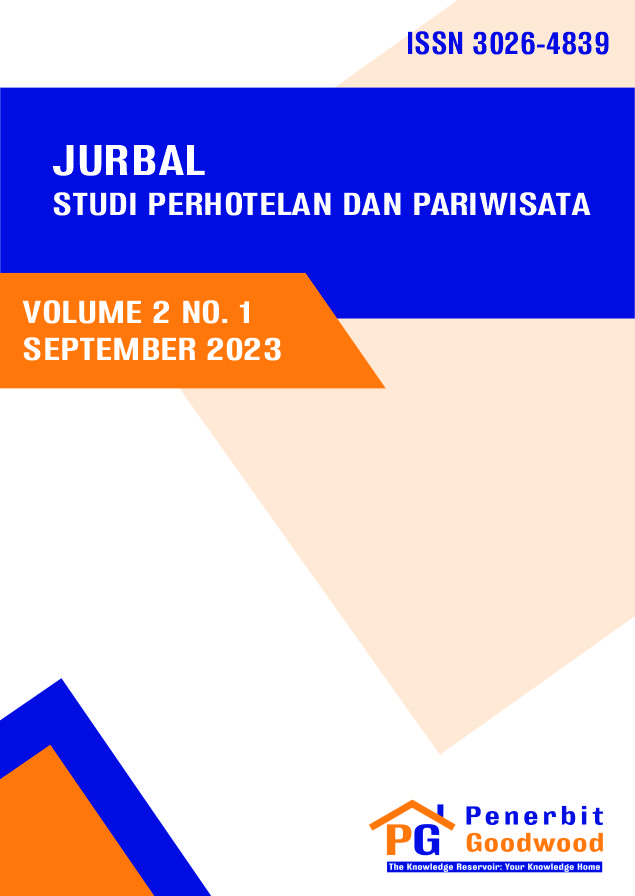Alternatif Wisata Desa Kerambitan Pasca Pandemi
Abstract:
Purpose: Kerambitan Village offers many culture, beauty, and beautiful places that are hidden and rarely known to outsiders. With creative ideas, ideal places for tourism and relaxation have emerged. With the Covid-19 pandemic, cultural tourism in Kerambitan Village has become empty for visitors. Given this situation, tourism managers are looking for alternatives, from cultural tourism to natural and culinary tourism. This makes tourist managers look for loopholes by taking advantage of natural tourism in the kerambitans. Natural tourism is currently very popular among tourists. This is also supported by village officials and the community around the natural tourist attraction so that it can restore additional income for residents near the tourist attraction.
Methodology: This research used a literature study with a qualitative descriptive approach and systematic review.
Result: The development of village tourism must pay attention to the sustainability of tourism, with cooperation between four stakeholders, namely the central government, tourism managers, village officials, and the community. A strategic approach is needed to develop sustainable tourism potential, namely the Quadruple Helix, by integrating civil society and integrating innovation and knowledge, the process of which involves collaboration between the government, tourism managers, village officials, and the community.
Limitation: With this background, this research provides limitations on the role of each stakeholder in developing village tourism in Kerambitan using the Quadruple Helix collaborative approach.
Contribution: With the Uma Friends tour and tourist visits to Kelating Beach and Pasut Beach, it becomes an income contribution to the village at the entrance of the two beaches.
Downloads
Afonso, O., Monteiro, S., & Thompson, M. (2012). A growth model for the quadruple helix. Journal of Business Economics and Management, 13(5), 849-865.
Dwija, I. K. P. M., Dewi, N. D. U., & Riniti, L. (2023). Kawasan Heritage Gajah Mada di Kota Denpasar sebagai Destinasi Wisata Alternatif. Jurnal Studi Perhotelan dan Pariwisata, 1(2), 89-98.
Hadiwijoyo, S. S. (2012). Perencanaan pariwisata perdesaan berbasis masyarakat: Sebuah pendekatan konsep: Graha Ilmu.
Klau, W. W., Fanggidae, A. H., Salean, D. Y., & Fanggidae, R. P. (2023). Strategi Pengembangan Objek Wisata dalam Upaya Meningkatkan Kunjungan Wisatawan: Studi Pada Objek Wisata Fulan Fehan. Jurnal Studi Perhotelan dan Pariwisata, 1(2), 53-61.
Muzaqi, A. H., & Hanum, F. (2020). Model Quadruple Helix dalam Pemberdayaan Perekonomian Lokal Berbasis Desa Wisata di Desa Duren Sari Kabupaten Trenggalek. Jurnal Sains Sosio Humaniora, 4(2), 673-691.
Priasukmana, S., & Mulyadin, R. M. (2001). Pembangunan desa wisata: Pelaksanaan undang-undang otonomi daerah. Info Sosial Ekonomi, 2(1), 37-44.
Rahman, A. Z., & Warsono, H. (2019). Kolaborasi triple helix dalam pembangunan wisata bahari di Indonesia. Jurnal Ilmu Administrasi Negara ASIAN (Asosiasi Ilmuwan Administrasi Negara), 7(1), 25-31.
Sugiyono, D. (2013). Metode penelitian pendidikan pendekatan kuantitatif, kualitatif dan R&D.
Sutama, I. K. G. S., Dewi, N. D. U., & Rahayu, L. R. (2023). Pengembangan Pariwisata dengan Community Based Tourism di Desa Wisata Penatih Denpasar. Jurnal Studi Perhotelan dan Pariwisata, 2(1), 1-11.
Tanesab, M., Fanggidae, A. H., Fanggidae, R. E., & Bunga, M. (2023). Strategi Pengembangan Wisata Air Terjun Oehala: Studi pada Kecamatan Mollo Selatan, Kabupaten Timor Tengah Selatan. Jurnal Studi Perhotelan dan Pariwisata, 1(2), 63-77.
- Afonso, O., Monteiro, S., & Thompson, M. (2012). A growth model for the quadruple helix. Journal of Business Economics and Management, 13(5), 849-865.
- Dwija, I. K. P. M., Dewi, N. D. U., & Riniti, L. (2023). Kawasan Heritage Gajah Mada di Kota Denpasar sebagai Destinasi Wisata Alternatif. Jurnal Studi Perhotelan dan Pariwisata, 1(2), 89-98.
- Hadiwijoyo, S. S. (2012). Perencanaan pariwisata perdesaan berbasis masyarakat: Sebuah pendekatan konsep: Graha Ilmu.
- Klau, W. W., Fanggidae, A. H., Salean, D. Y., & Fanggidae, R. P. (2023). Strategi Pengembangan Objek Wisata dalam Upaya Meningkatkan Kunjungan Wisatawan: Studi Pada Objek Wisata Fulan Fehan. Jurnal Studi Perhotelan dan Pariwisata, 1(2), 53-61.
- Muzaqi, A. H., & Hanum, F. (2020). Model Quadruple Helix dalam Pemberdayaan Perekonomian Lokal Berbasis Desa Wisata di Desa Duren Sari Kabupaten Trenggalek. Jurnal Sains Sosio Humaniora, 4(2), 673-691.
- Priasukmana, S., & Mulyadin, R. M. (2001). Pembangunan desa wisata: Pelaksanaan undang-undang otonomi daerah. Info Sosial Ekonomi, 2(1), 37-44.
- Rahman, A. Z., & Warsono, H. (2019). Kolaborasi triple helix dalam pembangunan wisata bahari di Indonesia. Jurnal Ilmu Administrasi Negara ASIAN (Asosiasi Ilmuwan Administrasi Negara), 7(1), 25-31.
- Sugiyono, D. (2013). Metode penelitian pendidikan pendekatan kuantitatif, kualitatif dan R&D.
- Sutama, I. K. G. S., Dewi, N. D. U., & Rahayu, L. R. (2023). Pengembangan Pariwisata dengan Community Based Tourism di Desa Wisata Penatih Denpasar. Jurnal Studi Perhotelan dan Pariwisata, 2(1), 1-11.
- Tanesab, M., Fanggidae, A. H., Fanggidae, R. E., & Bunga, M. (2023). Strategi Pengembangan Wisata Air Terjun Oehala: Studi pada Kecamatan Mollo Selatan, Kabupaten Timor Tengah Selatan. Jurnal Studi Perhotelan dan Pariwisata, 1(2), 63-77.

